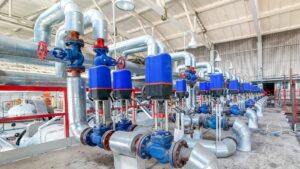
As an industrial business, your block valves are integral to the smooth and safe operation of your machinery. To ensure that they remain operational for as long as possible, it is important that they undergo regular industrial valve service, including testing as required.
Hydrostatic testing is a very effective way of keeping these vital components in full working order. This type of testing checks the valve’s performance pressure level and strength to identify any physical damage. It ensures that the valve is working as well now as it did the first day it went into operation.
With regular maintenance, you can maintain optimal efficiency in crucial industrial valve equipment all while saving money through preventative measures, instead of running to failure. Schedule a service appointment with Southern Valve Service today.
Why is Testing Important in Industrial Valve Service?
Industrial valves are a crucial component in any industrial application, from oil refineries to processing plants. Before being implemented in an operational capacity, they must go through a rigorous testing process to ensure their quality and reliability.
During the testing process, technicians monitor and analyze the valve’s performance, looking for any potential defects. Only once the valve has passed all required tests can it be considered ready for full use in industrial applications.
Hydrostatic testing is a common method used to determine whether there is any pressure loss in a block valve. The testing procedure involves filling the valve with a testing fluid, which is usually water, then increasing the pressure to check for any leaks or defects. This method allows for a thorough inspection of the valve body, components, and fittings.
The benefits of hydrostatic testing include detecting potential failures before they occur, reducing the risk of costly downtime, and ensuring compliance with industry regulations. With hydrostatic testing, industrial operators can have peace of mind knowing the valves meet safety standards and will operate at peak efficiency.
The Hydrostatic Testing Process
Before an industrial valve undergoes hydrostatic testing, there are several processes that must take place first. By following these steps, the test can produce accurate results to help guarantee reliable valve performance in crucial applications.
- Decontaminate: The block valve must be completely disassembled and fully cleaned. If not properly decontaminated, residual chemicals can corrode the valve when water is added during the testing process.
- Repair and Reassemble: All bolting should be replaced, new gaskets and seals installed, and all parts polished before reassembling the valve.
- Test: Hydrostatic testing uses water to bring the valve up to pressure and ensure it is operating at its original, factory-level capacity. This pressure must be maintained for a designated amount of time for accurate testing results.
- Prepped to ship: Once the valve has passed the testing process, it will be packaged for shipment.
During the testing stage, several different types of tests may be performed, depending on the type of block valve. The procedures for these tests are followed in accordance with API standards for valve inspection and testing. These may include:
Backseat test (optional): This is used for all valves that have a backseat feature, meaning that the valve packing can be replaced while the valve is still in service. This test is performed by applying pressure inside the assembled valve with the valve ends closed, the valve fully open, and the packing gland loose or packing not installed.
Shell test (required): This test checks the stuffing box, and is run by applying pressure inside the assembled valve with the valve ends closed, the valve partially open, and any packing gland tight enough to maintain the test pressure.
Low pressure closure test (required): This test looks for leakage at the seat sealing surface, behind the seat ring, or through the disk on the open side of the valve, by observing whether any bubbles rise out of the closure. In this test, the seat sealing service needs to be clean and free of oil, grease, and sealant, but instead coated with soap or a similar bubbling solution.
How Often Should Hydrostatic Tests Be Performed on Industrial Valves?
The frequency of these tests largely depends on multiple factors like the valve type, its application, and its history of use. Therefore, it is recommended to consult with the original valve manufacturers to determine the optimal testing schedule for each unique scenario. Generally, valves undergo this testing process when first manufactured, and usually operate on a two to four year testing cycle. With proper testing and maintenance, industrial valves can continue to operate safely and efficiently for long periods, saving time and money for businesses.
Effective, Experienced Industrial Valve Service
Hydrostatic testing of industrial valves is a critical process to ensure they meet safety and operational requirements. Regular testing can help minimize the possibility of unexpected failure and costly repairs for industrial valve owners.
Southern Valve Service has the experience and specialty processes to optimize the cost-effectiveness of your hydrostatic testing services. If you’re looking for a reliable and experienced partner for your industrial valve service needs, contact us now to schedule an appointment.
